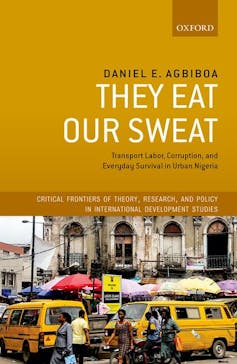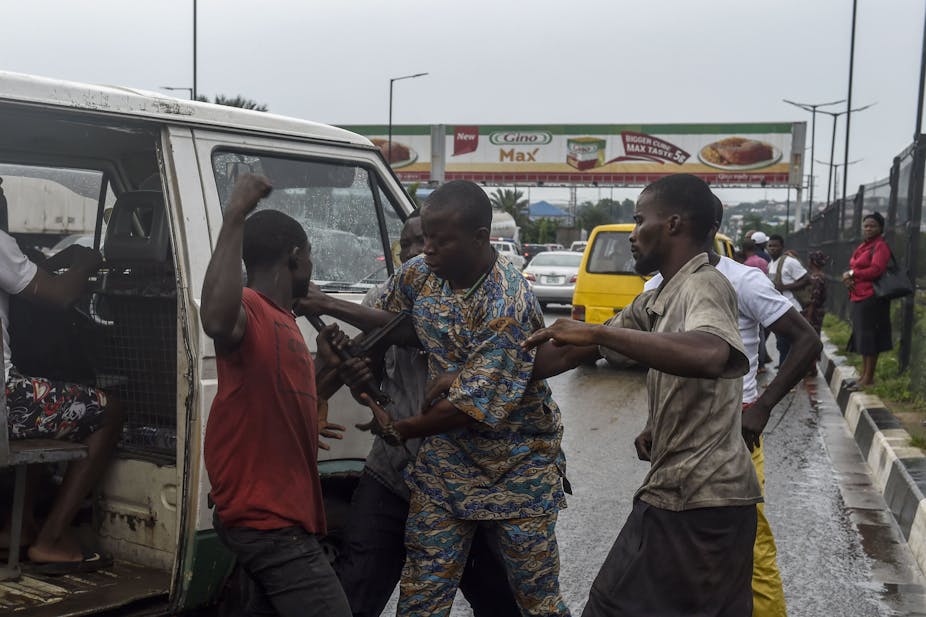Daniel E. Agbiboa’s book They Eat Our Sweat: Transport Labor, Corruption, and Everyday Survival in Urban Nigeria explores the world of drivers of minibuses (danfo) and motorcycles (okada) in Lagos, the economic capital of Nigeria. Agbiboa is assistant professor of African and African American studies at Harvard University. His research interests include the informal economy, urban change, mobility and youth politics.
The book describes the everyday interactions between the drivers, their conductors, union members regulating the garages through which they pass daily, and police officers. The drivers work 10 to 12 hours a day, six days a week, but go home without much revenue after paying daily “fees” or “dues” to bus owners, police officers and union members.
To gather materials for the book, Agbiboa worked as a conductor in a minibus for several months. He witnessed everyday forms of exploitation of these drivers by the police and touts. One driver summed it up:
I work tirelessly each day, while the ‘baboons’ (touts and police) stand in the roundabout and just chop (eat) my sweat.
Agbiboa reveals the micro dynamics of corruption and the drivers’ obligation to pay street-level bureaucrats from the National Union of Road Transport Workers and police.
His book is very welcome as he explores in detail the everyday survival of minibus and okada transport workers. Like many informal workers, transport operators have no fixed income, no days off and no social protection. And, as elsewhere on the continent, drivers have to speed to make ends meet. A central argument of the book is that corruption levels are high on the road.
My view, as a scholar of Nigerian history and political sociology, is that the book’s solid empirical base makes it an important study of transport working conditions in the country. Agbiboa usefully questions the distinction – recently established by critical scholars – between “capitalist owners” (of minibuses) and “proletarian workers” (who have only their labour to sell) in Africa’s cities. In Lagos, he suggests, the workers have the potential to earn more money than the owners.
The author also places Lagos in a larger conversation about informal transport in Africa’s cities, moving beyond any exceptional character of Lagos. He rightly insists there is order beyond the apparent chaos in African cities.
The book also documents the efforts of some transport associations to challenge state laws which deprive workers of their revenues. In an attempt to promote Lagos as a “world class city”, the 2012 Lagos State Law banned motorbike riders from operating on the most important roads of the state and wealthy neighbourhoods. Okada attempted to resist but eventually lost. The saga revealed the imbalance of power and the official narrative that associated motorbike drivers with crime, danger and disorder.
Read more: Nigeria's okada motorcycles have a bad image, but banning them solves nothing
.
Extortion and complicity
Agbiboa suggests the daily encounters between agbero (the agents who collect fees from drivers for the transport union), drivers and police agents are marked by extortion and complicity.
The book asserts complicity between agbero and police agents and never between agbero and drivers. My own observations in several motor parks in Lagos suggest, however, that there isn’t always complicity between agbero and police, and that complicity between agbero and drivers is very common. Most agbero and drivers work together daily in the same garage for years, sometimes for decades. They know each other and develop various forms of sociability that could not be reduced to violent exploitation.
To a large extent, the book presents the drivers’ perspective, more than that of union members, whose voices are rarely heard. Most drivers are not members of the National Union of Road Transport Workers, but former drivers are often union members.
The union is powerful in regulating transport and plays a key role in electoral politics, two dimensions that remain to be explored in more detailed empirical works.
The book presents the union mainly as a criminal organisation. The author defends the hypothesis of a predatory union-state alliance that “eats the sweat” of drivers. This view has merit but it probably needs further explanation.
My own research suggests there are more ambivalent relationships between union members, state officials, police and military officers at the grassroots level. Union members are often in conflict with the police while negotiating with police officers for the release of their drivers from police stations or jails. None of them want the drivers working under their authority to be arrested, and many of them try to protect them against police extortion in order to keep business flowing.
Agbiboa makes a welcome distinction between agbero identified with a specific garage or motorpark and “area boys”, or “delinquents” associated with a particular neighbourhood. Agbero do not want to be associated with crime: they think of themselves as workers. Still, agbero are criminalised in the book. They are the easy target of public criticism.

Agbero seen as outlaws
Drivers insist that agbero are making easy money from their work but, as my research has found, agbero are often in the same precarious conditions as transport workers themselves. Their leaders impose on them a daily revenue target to be taken from the drivers. Many of them hardly make a living from their work.
In my view, the agbero has become the new figure of a long history of criminalisation of poor young urban men. Transport in Nigeria could be better understood if agbero were analysed as the least powerful members of the union working for the benefit of more powerful and better connected members of society: union bureaucrats, government officials, politicians and law enforcement agents who have a common interest in keeping this revenue system intact.
These remarks aside, Agbiboa’s book is the most detailed and accurate account of Nigeria’s road transport system so far.

